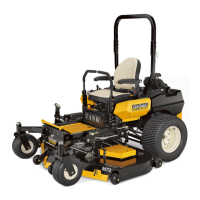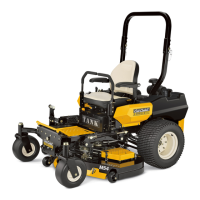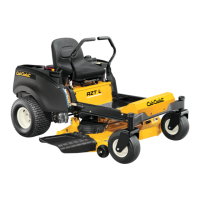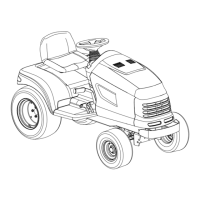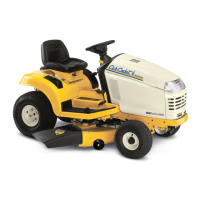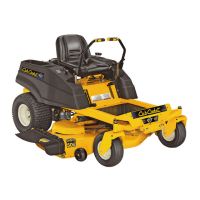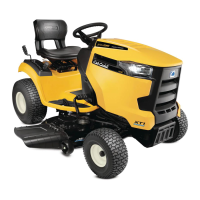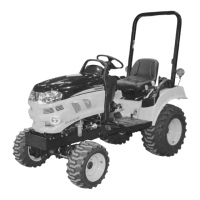Section 5 — operation 21
7. Turn the ignition key clockwise to the START position
and release it as soon as the engine starts; however, do not
crank the engine continuously for more than 10 seconds
at a time. If the engine does not start within this time, turn
the key to STOP and wait at least 30 seconds to allow
the engine’s starter motor to cool. Try again after waiting.
If after a few attempts the engine fails to start, do not keep
trying to start it with the choke closed as this will cause
flooding and make starting more difficult.
8. Once the engine starts, push the choke halfway down and
as the engine warms, push the choke all the way down.
Cold Weather Starting
When starting the engine at temperatures near or below freezing,
ensure the correct viscosity motor oil is used in the engine and the
battery is fully charged. Start the engine as follows:
1. Be sure the battery is in good condition. A warm battery
has much more starting capacity than a cold battery.
2. Use fresh winter grade fuel. Winter grade gasoline has
higher volatility to improve starting. Do not use gasoline
left over from summer.
3. Follow the previous instruction for Starting the Engine.
Using Jumper Cables To Start Engine
WARNING! Batteries contain sulfuric acid and
produce explosive gasses. Make certain the area is
well ventilated, wear gloves and eye protection, and
avoid sparks or flames near the battery.
If the battery charge is not sufficient to crank the engine,
recharge the battery. If a battery charger is unavailable and
the tractor must be started, the aid of a booster battery will be
necessary. Connect the booster battery as follows:
1. Connect the end of one cable to the disabled machine
battery’s positive terminal; then connect the other end of
that cable to the booster battery’s positive terminal.
2. Connect one end of the other cable to the booster
battery’s negative terminal; then connect the other end of
that cable to the frame of the disabled tractor, as far from
the battery as possible.
3. Start the disabled tractor following the normal starting
instructions previously provided; then disconnect the
jumper cables in the exact reverse order of their connection.
4. Have the tractor’s electrical system checked and repaired
as soon as possible to eliminate the need for jump starting.
Stopping the Engine
1. Disengage the PTO.
2. Move the RH and LH drive control levers fully outward in
the neutral position.
3. Engage the parking brake.
4. Move the throttle control to midway between the SLOW
and FAST positions.
5. Turn the ignition key to the STOP position and remove
the key from the ignition switch.
NOTE: Always remove the key from the ignition switch
to prevent accidental starting or battery discharge if the
equipment is left unattended.
Practice Operation (Initial Use)
Operating a zero-turn tractor is not like operating a conventional
type riding tractor. Although and because a zero turn tractor is
more maneuverable, getting used to operating the control levers
takes some practice.
We strongly recommend that you locate a reasonably large,
level and open “practice area” where there are no obstructions,
pedestrians, or animals. You should practice operating the
tractor for a minimum of 30 minutes.
Carefully move (or have moved) the tractor to the practice area.
When performing the practice session, the PTO should not be
engaged. While practicing, operate the tractor at approximately ⁄-
⁄ throttle and at less than full speed in both forward and reverse.
Always wear appropriate clothing and personal protection
equipment (e.g. safety glasses, long pants, gloves, hearing
protection, safety shoes, hard hat) when operating or
maintaining this machine. Follow all federal, state and local
guidelines regarding the use of personal protective equipment.
Carefully practice maneuvering the machine using the instructions
in the following section “Driving the Tractor.” Practice until you are
confident that you can safely operate the tractor.
Driving the Tractor
1. Ensure that the area is free of animals and bystanders,
especially children!
2. Survey the area where the equipment is to be used to make
sure it is free of debris, sticks, stones, wires, bones, and other
foreign objects which could cause injury to bystanders,
damage to the machine, or damage to nearby facilities.
WARNING! Avoid sudden starts, excessive speed
and sudden stops.
3. Adjust the operator’s seat to the most comfortable
position that allows you to operate the controls. See seat
adjustment in the Assembly & Set-Up section.
4. Release the parking brake.
5. Move the RH and LH drive control levers inward in the
neutral position. Refer to Figure 5-1.
Control Lever Moved
Inward and in Neutral
Figure 5-1
NOTE: If the control levers are not even in the neutral
position, refer to Assembly & Set-Up for instructions to
adjust the levers so that they are even.
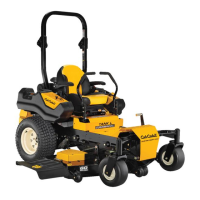
